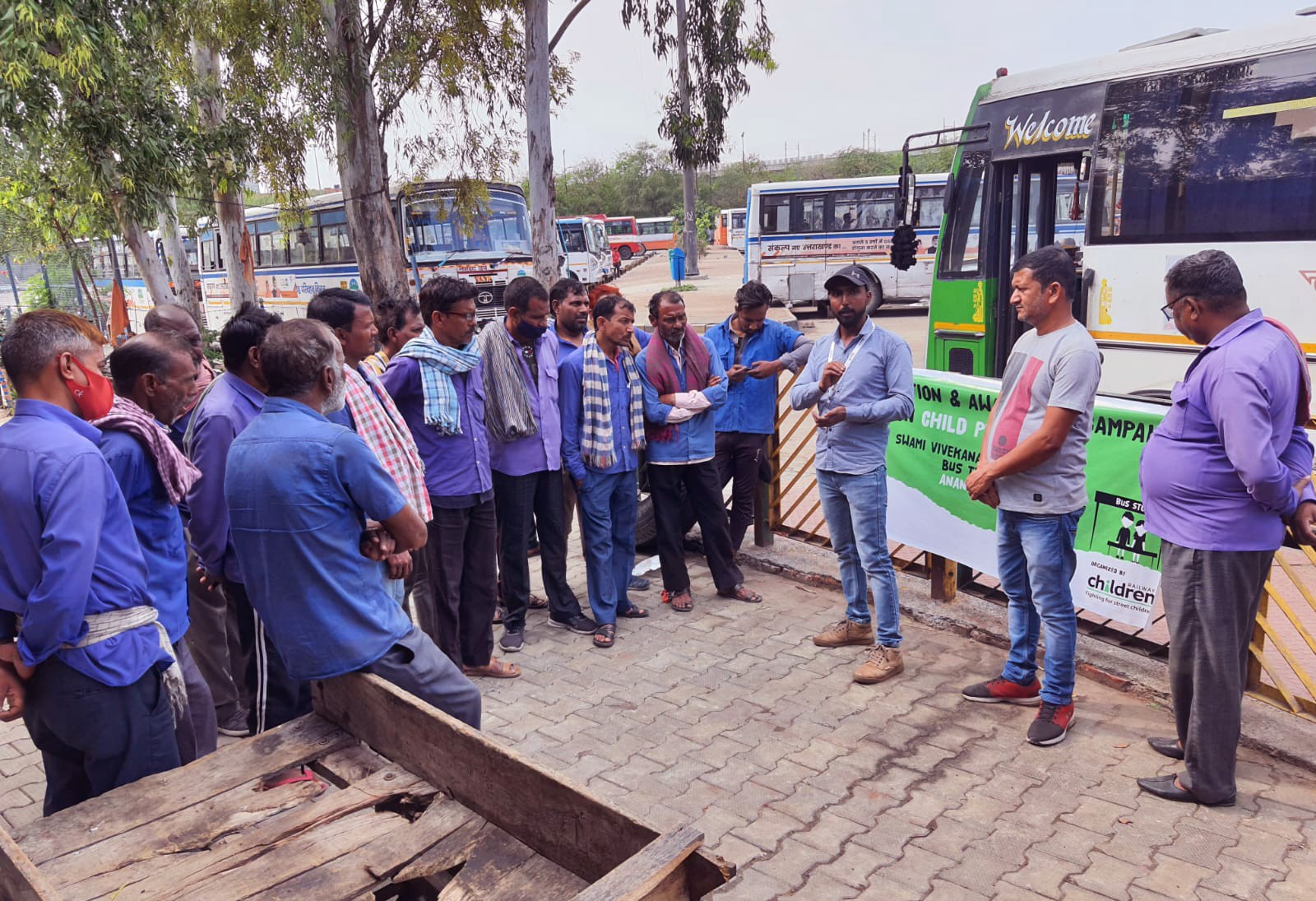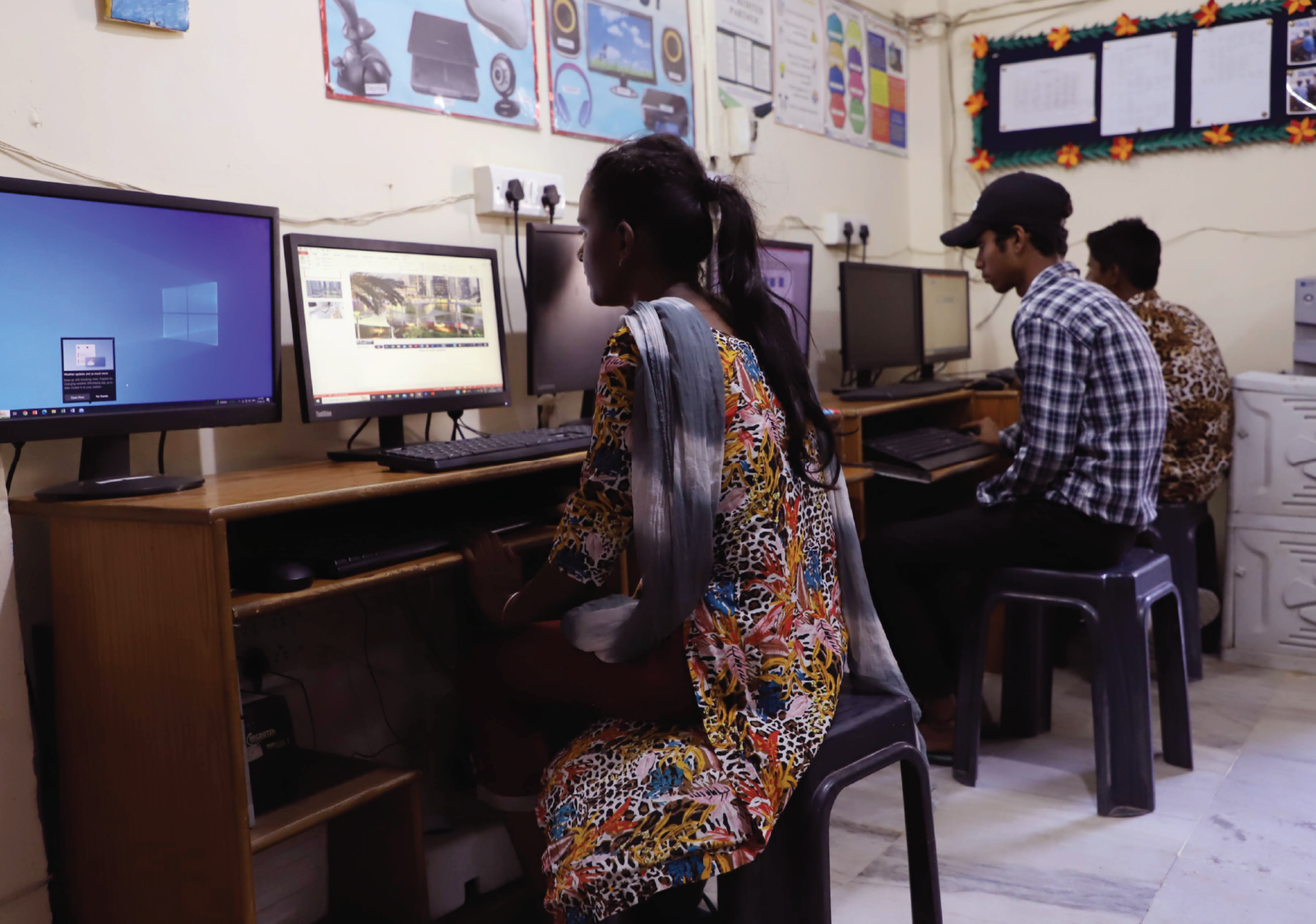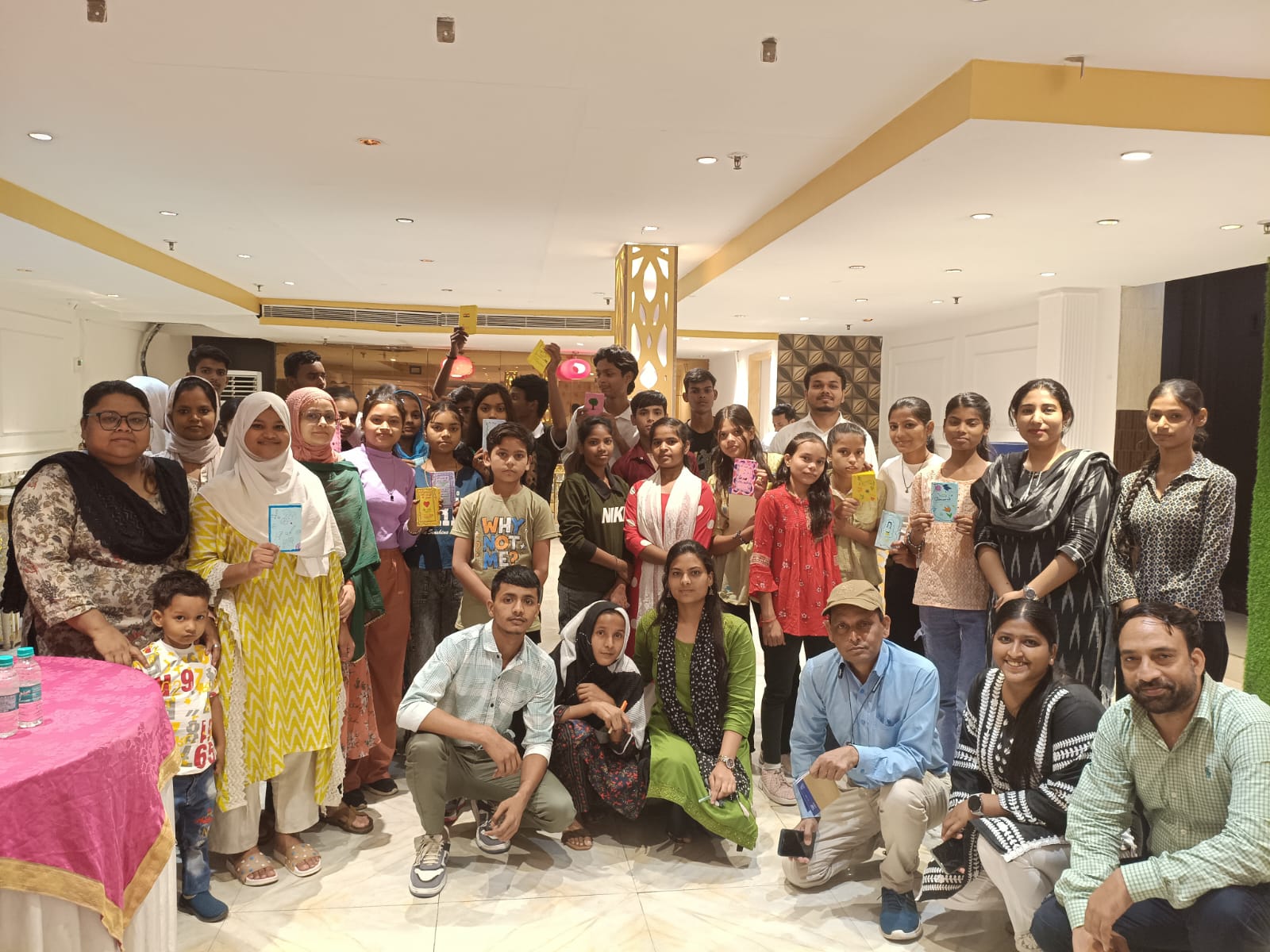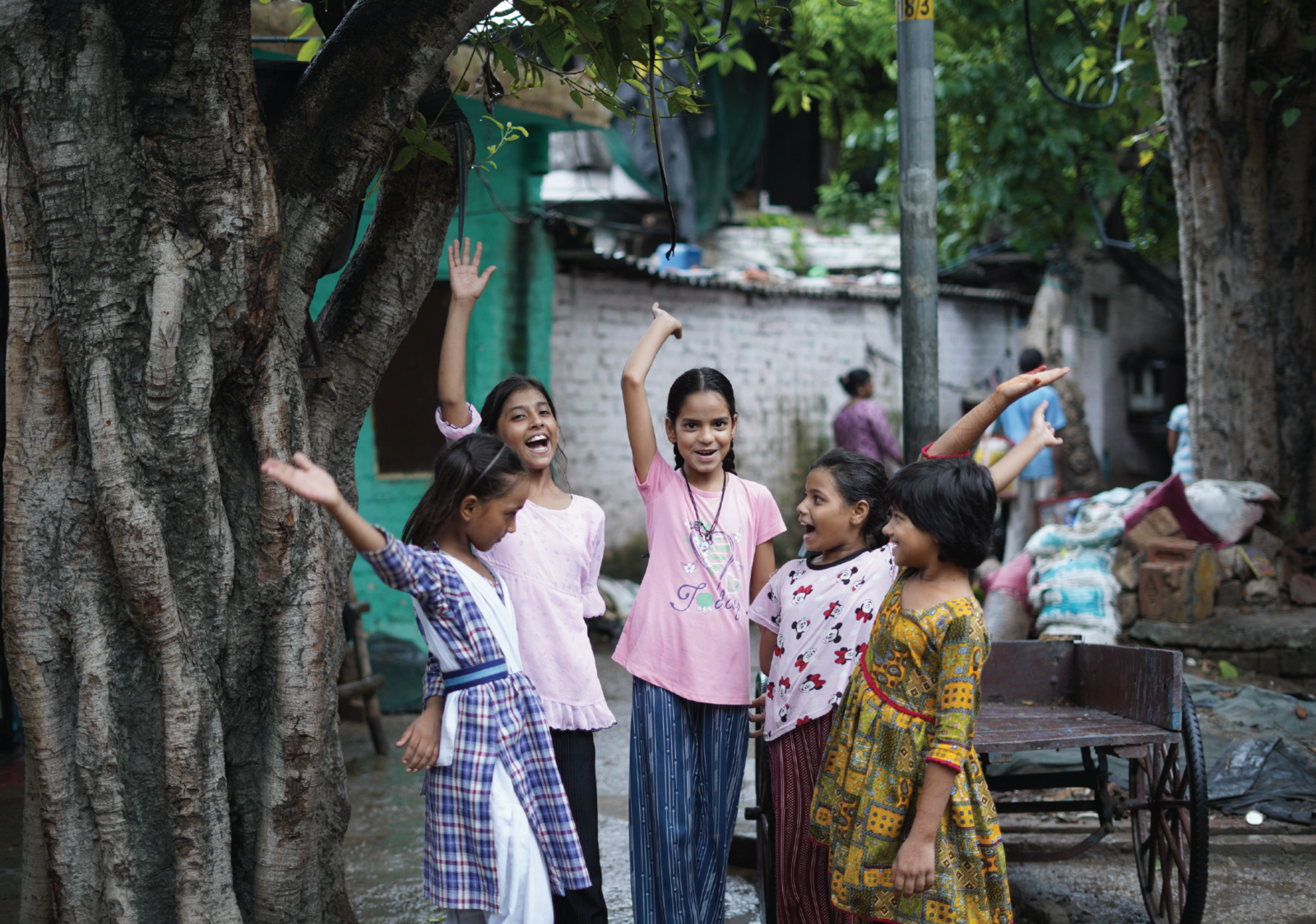Rahis Salmani, Project Lead for Anand Vihar Bus Terminal speaks with bus terminal staff on how to identify children at-risk in moving buses and bus terminals
Bus terminals, especially those like the massive and bustling intercity Anand Vihar Bus Terminal (AVBT), are potential hot spots for trafficking, exploitation and movement of at-risk children, without child protection mechanisms in place. Often, thousands of children using buses remain unattended, and could be lost if not rescued in a timely manner.
Railway Children India recently extended its scope of work by initiating intervention at AVBT. Here in an in-depth interview, Rahis Salmani, Project Coordinator at AVBT, discusses the purpose, intent and impact of RCI’s intervention at the bus terminal.
Tell us a little about your work at Railway Children India (RCI), describing a typical day at work and the various activities that help you reach and protect children.
I am a Project Coordinator, currently posted at the Anand Vihar Bus Terminal (AVBT). My role entails early identification by interacting with abandoned, lost or at-risk children on a regular basis, as I streamline and monitor the entire process of reaching out to them and reuniting them with their families. My day begins by briefing the team about the daily agenda and interacting with stakeholders such as police personnel and vendors milling about the bus terminal. After reaching out to a child, there are a series of steps such as fulfilling their immediate needs of providing food, water, and/or first aid, making a daily diary entry, overseeing their medical assessment, and producing them before the Child Welfare Committee. I resolve issues that the team or children face in between these steps and streamline this process.
Planning and overseeing regular outreach activities upon identifying a lost child or even a group of children are an important part of my day, followed by documenting these incidents. Apart from these, we conduct routine relation-building activities with district authorities. These activities include enabling awareness programs and coordinating with government bodies in detailing our work.
Intervention at the Anand Vihar Bus Terminal (AVBT) is RCI’s first project at a bus terminal. In your experience, why was there a need to initiate an intervention at a bus terminal and how is it different from outreach work at a railway station?
Yes, RCI’s interventions were so far conducted exclusively at railway stations, making this our first intervention at a bus terminal.
The Anand Vihar Bus Terminal is one of the biggest Interstate Bus Terminals not only in Delhi, but also in India. Given its geography, this location has immense potential as a hub of abuse and exploitation of children. Neighbouring this bus terminal is the Anand Vihar railway station, metro station and the Kaushambi bus stand. More importantly, the Delhi—Uttar Pradesh border is close to this bus terminal. It is important to have a preventative and early identification presence here because it’s very easy to transport children to and from here, without anyone ever noticing any wrongdoing.
As for the difference of intervention between a railway station and a bus stop, the foremost difference is the presence of a well-established Standard Operating Procedure at a railway station and the lack thereof at a bus terminal. Railway personnel and other stakeholders present at a railway station are much more aware and sensitive about child protection, with everyone, including commuters, actively referring a lost/abandoned child to the officials.
When compared with a train station, the awareness about child protection is quite low at a bus terminal, and the mechanism of referring a child is practically unknown here. Children are seen roaming the premises of the bus terminal looking lost, without anyone approaching them to help. Children can easily access a bus terminal and are seen merging into the environment easily, by means of either polishing shoes, selling items or picking rags. Essentially, it is easy for people to neglect children at bus terminals, making an intervention such as ours important.
What has been the trend at Anand Vihar Bus Terminal regarding runaway, abandoned or missing children and what is RCI’s plan of action to protect children at risk who use the transport network?
RCI’s intervention began full-fledged at the AVBT in November 2022. Since then, we have observed that children hailing from regions with scant rail networks, such as Sikandarabad, Bulandshahar and other cities from the Purvanchal region of Uttar Pradesh, are more prone to arriving at this bus terminal via the Delhi-UP border. They arrive here either by trafficking or by choice in hope of acquiring work. At this tender age, they find themselves engaged either in menial jobs such as rag picking and daily wage labour or hazardous jobs such as those offered by the many tobacco companies populating the nearby Patparganj Industrial Area. Once they arrive and secure a job, they reside in the slums of Ghazipur and the nearby neighbourhoods.
A noteworthy point here is that these children are neither associated with any of the Government schemes nor found in any NGO’s network. We identified this major gap and set a plan of action in motion that entailed collaborating with the District Child Protection Unit, reaching out to them and making sure that we enrol these at-risk children in the education system. Our interactions with children also revealed a worrying trend of rampant substance abuse among children as young as six years old!
As for migration patterns, we’ve observed a common trend whereby children have had to flee from their homes due to extremely vulnerable situations. As a result, a traumatised mental state was commonly seen among several children, thereby making family integration and access to higher education an important aspect of their rehabilitation.
Please share a case study that best highlights the need for such intervention along the Howrah Delhi Network.
Once our outreach team spotted 2 young boys selling scrap at the bus terminal. After we approached them, they shared that they had come here from West Bengal 2 months ago and since then were staying at a nearby slum with a lady who had helped them bag the job. The boys were aged between 9 to 11 years. They shared that they had not had a proper meal since they came to Delhi, 2 months ago, neither had they showered since. All they wanted was to go back home, but they were unaware of how to make the move.
We initiated the procedure, fulfilled their basic needs and produced them before the CWC promptly, who directed us and the local authorities to trace their families. While we traced their families with clockwork co-ordination between state police personnel, the children were staying at a childcare institution. I am happy to share that within a week, we were successful in reuniting the boys with their family.
This is one case study that flashes in my mind. It details all the potential harms that lies ahead in the paths of innocent children who feel trapped in cities, away from their homes and more importantly away from their basic rights. This is an example of the dire conditions children find themselves in and the need for structured rescue and rehabilitation programs for them.
What is that one thing about your work that keeps you inspired? How do you keep your team members, stakeholders, passengers and the whole transport ecosystem motivated to protect children?
I have completed 7 years in the field of child protection, having worked with RCI for 6 years. I began my journey as an outreach worker and worked my way up as a Project Coordinator. In learning their stories and interacting with children, I feel a deep connection with them and an undeniable feeling of love and care.
Having facilitated reunions of many children with their families, I am aware of the hopelessness that families feel at the loss of their children. The sole thought that motivates me in my task is the assurance that I am helping abandoned children and families who have lost hope. Having completed my graduation and post-graduation both in social work, it’s needless to say that my work is my passion. Bringing children home and saving those who have lost their way to bad influences drives me.
My team also finds motivation and confidence in the appreciation they receive from stakeholders, families and children. I too keep motivating them by reminding them that they’re doing a great job and for a good cause.
As for communicating with stakeholders, it is important for the readers to know that over 2000 buses ply every day to and from AVBT. Naturally, the number of stakeholders in the bus terminal is extremely high, making constant communication difficult for us. We do find ways of managing these numbers with 1-to-1 marking. With this technique, we assign 1 outreach worker to 1 stakeholder each, i.e., 1 driver, conductor, security staff, vendor, cleaning staff and police personnel. We also distribute informational pamphlets, which educate stakeholders about recognizing children in distress and the following rehabilitation mechanisms. On a weekly basis, we also conduct focused group discussions with various stakeholders where we share our work in greater detail with them.







